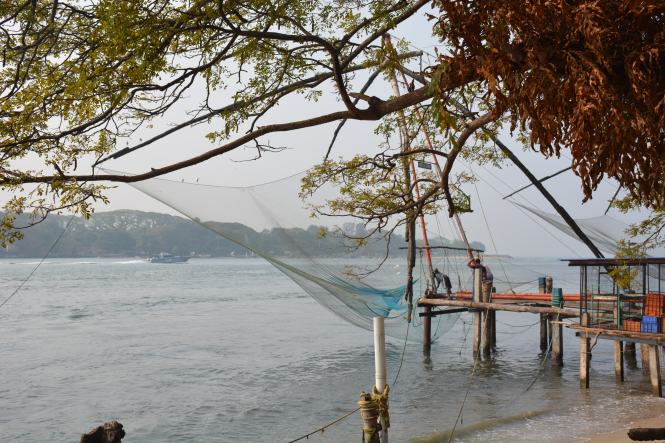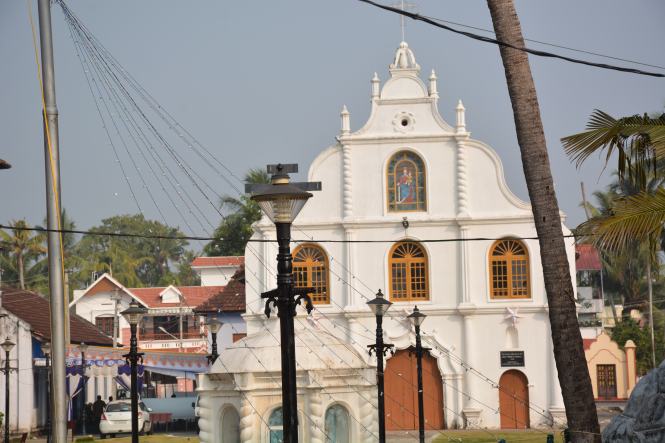It would have been easier for everyone if the district would have been called Kochin instead of Ernakulam. But, no. Goad’s Own Country does not follow the ordinary rules. For everything there is a reason and there is a history.
I started the previous paragraph to write about Cochin. If I had written it as Kochi in my school days, Mr. Pillai our geography teacher would have thrashed me for wrongly spelling his hometown. That was in 1970s. Cochin became Kochi in 1996.
Kochi is often called the Queen of Arabian Sea. It came into prominence from 1341 AD onwards when the then major port north of Kochin called Muziris was destroyed in a major flooding. Remember this place ? this is where St Thomas landed from the Middle East with the message from the new Messanger of God? Here we are talking of 14th century when the sea route to India via Cape was not discovered. However, the city was known to the Romans, Greeks, Jews, Chinese and Arabs of course. The first three were using a combination of land and sea routes. The guy called Vasco da Gama who used the exclusively sea route around the came much later.
We (No, Vasco is not with us these days) start early morning from Ernakulam and start exploring the district from the northern side. The first stop is Santa Cruz Cathedral. Majestic structure with an imposing view as you approach it.

Santa Cruz cathedral
Idols are aplenty around. Beautiful.
Vypin island and Cherai beach follows.
A lot of history must be hidden in the islands of Ernakulam district. A lot.

This is the place from where you start seeing the Chinese Fishing Nets. Why from here? I dont know but I will write a bit about these nets a little later.
Vypin Island has a small beach and a nice little Church.

But the place is dominated by the CFNs, I mean Chinese Fishing Nets. The CFNs that you see in the picture postcards are located on the Vypin island but the shot from the opposite side , Cochi town. Let me add a picture here from Vypin proper.

Chinese Fishing Nets
Pallipuram Fort is the northernmost place in Ernakulam. To the north is another part of history – Kodangallore-Muziris Axis.
This place was built by the Portuguese in 1503 and is now considered as the oldest surviving European built structure in India. Congratulations, Pallipuram. it was owned by the Portuguese, the Dutch, the English and the local Kings at various times in history. It was taken over by the Indian government not from the British but from the Travancore kings.
It is not easy to visit this place. That explains why it is not on the Tourists Menu. It takes the grit of TheBlueDrive to find such places and actually visit them, not post the borrowed pictures.
It was risky to park the car on the extremely busy and very narrow road. There is no option.
It is to the credit of Kerala Dept. of Archaeology that the fort is still in good shape.


The creek is very close to the fort. As usual there is no information available at site but the lady who was cleaning the place showed us what appears like an underground passage that perhaps led to the creek waters in the past.


Our next stop is the Vypin Lighthouse. If you are allowed to visit only one place in Kerala before you are executed, opt for the Top of Vypin Lighthouse.
Here is why:



Water is everywhere , so are the Goads.
The lighthouse itself is infested with young people with their Android phones taking ‘selfies’ with their friends .The reason for the popularity of the lighthouse ? it is among a very few in India which has a lift. TheBlueDrive with average age of 60 climb most of them with or without lift ( for the benefit of the Americans, Lift means Elevators). Anyway, from the outside the Lighthouse looks like this.
Cochi has so much history that there is very little place for anything else. The Mattancherry Palace. ( Cameras not allowed inside, so very little can be shared).
The Cochin Fort abutting the beach.
You walk along the beach and find a place called ‘Gunnery’. Logically it should have been a part of the Fort and inside the ramparts.
And then a few meters away something the Dutch are famous for in India- Cementaries.The Dutch cementaries are the best European resting places in India. I can say this the benefit of having seen most of them.
How can I ignore the 511 years old Santa Cruz Basilica?
Heart of Jesus Church.

On the Mattanchery side is the Jew Town which is a bazar but still has the old buidings including the Synagogue. They no longer allow you photograph inside the Synagogue but I still have the ‘negatives’ of the film of the previous visit when we used to use ‘film’ for photographing. I need to go back into my archives and find them.

The Synagogue
The fear of the dead is inversely proportional to the time elapsed from the date of death. The recently demised invoke more fear than those who died in the distant past. The people of Kochi are closing in on the Jewish graves. They are not likely to be here for long.
Kochi has at least three Museums. The Mattanchery Palace Museum and the Indo-Poruguese Museum do not allow photography. The third museum is the Maritime History Museum of Indian Navy. If you want to uderstand the Maritime history and the major players on the western seaboard of India, a visit is to this museum is a must.
Apart from the major players the museum allows us a peek into the types of boats and vessels used in ancient times.
Apart from this the exhibits trace the history of Indian Navy and also the European fortifications on India’s coast.
Thed details are beyond the scope of this blog. Suffice it to say that a visit is recommened.
There are many other aspects of Ernakulam/Cochin life which need to be writen about. To limit the size of the post I will be merging them with other places as we go along as many of the aspects overlap. The Chinese Fishing Nets and the Fish Sellers of Kerala are aming them.
Please allow me conclude this post here.
Text and Pictures by Suryakiran Naik





































